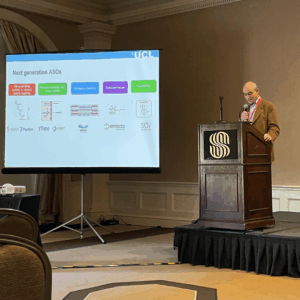Recently, PPMD led a meeting with experts from across the US and Europe to discuss the evolving understanding of brain and behavior implications in individuals with dystrophinopathy. The two day workshop, led by Drs. Molly Colvin (Massachusetts General), Natalie Truba (Nationwide Children’s Hospital) and Francesco Muntoni (University College London), focused on how dystrophin impacts brain structure and function, behavior, and emotional wellbeing. Clinicians and researchers discussed screening tools, the critical role of interdisciplinary collaboration, medication use and their effects on behaviors and other treatments to better support children and adults throughout their lifespan.
Here are some key themes to emerge from the workshop and guide future work:
Dystrophin’s role in the brain
Dystrophin isn’t just one protein. There are several forms, called isoforms, that are active at different stages of brain development. Some appear more during childhood as the brain develops, with others more prominent in adolescence and adulthood. These isoforms are especially active in parts of the brain that help us process emotions, form memories, and interpret social cues — areas in the brain, including the amygdala and hippocampus.
A 2025 study showed that the absence or reduction of these dystrophin isoforms can affect how the brain regulates emotions and attention. Without enough dystrophin, the brain’s excitatory and inhibitory systems can get out of sync. Imagine a car with a sensitive gas pedal and weak brakes: it might react too strongly or take longer to slow down.
 In dystrophinopathy, this can mean:
In dystrophinopathy, this can mean:
- Overreacting to perceived stress or “social threats”
- Increased heart rate or muscle tension
- Difficulty calming down after emotional moments
Scientists believe this imbalance may be related to reduced levels of GABA (an inhibitory neurotransmitter) and changes in glutamate (an excitatory neurotransmitter). These chemical messengers help the brain manage signals that affect focus, mood, and social interaction.
What brain imaging tells us
MRI studies help us see what’s happening inside the brain more clearly.
- Individuals with dystrophinopathy often have slightly smaller total brain and gray matter volumes than peers without dystrophinopathy,
- The brain’s white matter, which connects regions and helps signals travel efficiently, shows subtle differences in structure and connectivity.
- Brain blood flow was found to be about 17% lower in those with dystrophinopathy, even when adjusting for brain size.
- Functional imaging shows greater activation in the “default mode network,” a brain system that’s more active, like when we’re daydreaming.
- Brain chemistry also varies — for example, glutamate levels are more variable in the frontal cortex, which can affect planning, emotional control, and attention.
Together, these findings support what many parents notice: that learning, attention, and emotional regulation can feel more challenging in dystrophinopathy — but these are biologically based, not due to effort or parenting style.
The impact of corticosteroids
Corticosteroids, like prednisone, deflazacort, and vamorolone, are a gold-standard in the treatment of Duchenne. But because they cross the blood-brain barrier, they can also affect the brain.
Inside the brain, corticosteroids interact with two main types of receptors:
- Mineralocorticoid receptors (MR): help maintain calm, balance, and stability.
- Glucocorticoid receptors (GR): help the brain respond to stress and adapt, but when activated for too long, they can increase anxiety and emotional reactivity.
Daily steroid use may contribute to subtle changes in brain structure or emotional regulation, especially over time. Studies suggest that intermittent dosing may reduce some of these effects. This highlights the importance of discussing emotional and behavioral side effects with your care team.
Newer treatments like vamorolone may have fewer effects on brain and mood pathways, and studies are underway to better understand these differences.
 Behavior in everyday life: what this looks like
Behavior in everyday life: what this looks like
When decreased dystrophin is present in the brain, individuals may experience:
- Anxiety and resistance to new routines or unfamiliar people
- Rigidity: wanting things to stay the same, saying “no” automatically
- Perseveration: getting stuck on a thought or question
- Impulsivity: blurting, interrupting, or struggling to wait
- Difficulty with transitions: needing predictability to feel safe
- Sensory sensitivities: reacting strongly to sound, touch, or light
- Social challenges: missing nonverbal cues or interpreting jokes literally
These are not signs of “bad behavior.” They reflect how the brain processes information differently. The key is understanding the “why” behind the behavior, and responding with empathy and structure.
What families can do
- Recognize patterns early. Ask your care team about neuropsychological testing or early intervention programs.
- Create predictable routines. Structure provides comfort and stability.
- Use clear, literal language. Avoid metaphors or criticism when possible.
- Allow extra processing time. Give space for your child to respond or shift between tasks.
- Celebrate strengths. Many children with dystrophinopathy have exceptional memory, creativity, humor, and empathy.
- Ask for sensory-friendly environments. Occupational therapists can help with “sensory diets” to manage input and regulation.
- Collaborate with schools. Share resources and information with your child’s school to support teachers in their understanding of the biological basis for learning and behavior in individuals with dystrophinopathy. Resources like Education Matters, PPMD For You, and the Educators Masterclass can help.
Filling the gap
Workshop attendees shared information about tangible tools to support families in the screening, diagnosis, and management of behaviors to help make a difference in daily life.
- The BELS tool, developed by Dr. Truba and Dr. Covlin, aims to serve as a widely available screening tool to identify areas where referrals or additional care may be useful across four domains: behavioral, emotional, learning, and social difficulties. This tool is currently undergoing validation studies and will be more broadly available to US-based families in the coming months.
- The BIND screener, developed by Dr. Jos Hendriksen and the BIND consortium, which aims to develop a tool to identify “red flags” for neurodevelopmental disorders, contribute to improved health care practices, and empower both professionals and parents. The BIND screener will be distributed broadly by World Duchenne Organization (WDO) while additional studies continue to better understand additional uses of the tool in additional populations.
- The DuMAND Checklist, developed by Dr. Liesbeth De Waele, Dr. Sam Geuens, and their colleagues at UZ Leuven (Belgium), similarly serves to screen for neurobehavioral concerns in dystrophinopathy across five categories: cognition and learning, social responsiveness, emotion regulation, externalizing behavior, and eating and sleeping. This tool was initially piloted on a cohort of patients in Belgium; future plans include use across the DuMAND network with a goal of better understanding behavioral changes over time.
Additionally, the early development of a medication use algorithm was discussed, outlining potential pathways to standardize the use of medications – both preferred and those to avoid – in dystrophinopathy for the treatment of symptoms across five key domains:
- Insomnia
- Anxiety
- Depression
- Attention Deficit Hyperactivity Disorder
- Aggression, Irritability, and Self-Injurious Behavior
Future directions
This workshop was a major step towards better integrating brain and behavior health into dystrophinopathy care. As one speaker said, “Our goal isn’t to change the child — it’s to change the environment so every child can thrive.”
PPMD will continue to work with key leaders towards the validation and implementation of screening and assessment tools, better access to psychosocial and behavioral resources, and support collaboration between researchers, clinicians and families across the world. Additionally, PPMD looks forward to sharing in more detail the outcomes of this workshop in coming months as discussions shape areas for focus in PPMD programming and support.
To stay up to date with PPMD’s efforts, the latest in care, research, community and advocacy, sign up for our email list.



The post Advancing Brain and Behavior Care in Dystrophinopathy appeared first on Parent Project Muscular Dystrophy.
